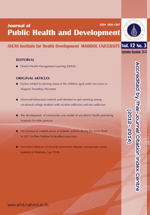Factors Related to Medication Adherence among Essential Hypertensive Patients in Tertiary Hospitals in Yangon, Myanmar
Main Article Content
Abstract
Poor adherence to medications is one of the major public health challenges. Due to little study on the
adherence to anti-hypertensive treatment in Myanmar, where the prevalence of hypertension is the highest
among South-East Asian Countries (42%), this study aimed to determine the prevalence of the adherence and
to identify the factors related to medication adherence among hypertensive patients in Yangon, Myanmar.
A hospital-based cross-sectional study was done on a sample of 216 hypertensive patients who recruited
by convenient sampling method at tertiary hospitals in Yangon, Myanmar during April and May 2015. Face-
to-face interview was conducted using a structured questionnaire to gather information on socio-demographic,
knowledge, perception, self-efficacy, family support and cues to action. The medication adherence was
measured by Morisky Medication Adherence Scale (MMAS-8). “Good adherence” was defined as MMAS-
8 scores of 6 or greater out of a total score of 8 points whereas “Poor adherence” as point of less than 6.
Descriptive statistics, chi-square test and multiple logistic regressions were used for data analysis.
Only 50% of hypertensive patients were reported as good adherence to anti-hypertensive medication.
Using backward multiple logistic regression, younger age (adjOR=3.03, 95%CI=1.15-7.99), male patients
(adjOR=1.84, 95%CI=1.01-3.37), low household income (adjOR=2.39, 95%CI=1.17-4.85), longer duration of
hypertension (adjOR=4.00, 95%CI=1.87-8.59 for those within 1-3 years and adjOR=2.63, 95%CI=1.12-6.20
for those with more than 3 years compared to those less than 1year)) and higher level of perceived barriers
(adjOR=2.55, 95%CI=1.27-5.09) were related with poor medication adherence.
This study reported relatively high proportion of poor medication adherence. With regard to perceived
barriers, such as medication side effects and complex dosing, health education program can be designed in
out-patient settings particularly for patients with a long duration of hypertension. In addition, implementation
of health insurance system should be considered to address external barriers like financial problem.






